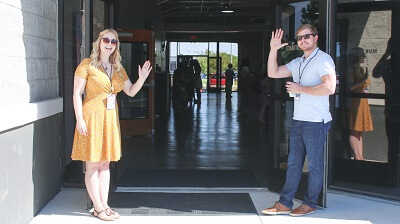In certain situations, such as in-office settings, schools, hospitals, and other facilities where you may have a repeat, transient interactions with co-workers and other staff, constantly encountering others will often lead to many introductions.

When you don’t have the opportunity to have an in-depth conversation, confusion may arise regarding how to maintain proper social etiquette without offending others.
You don’t have to say “Hi” every time you meet someone. Especially in the workplace, it’s an unwritten law that there’s not something to talk about every time you meet. In these cases, a simple nod or a friendly smile will suffice.
Fortunately, there is much flexibility regarding how you choose to interact with co-workers and colleagues that permits one to say “Hi” in a manner that suits individual preference.
When to Greet Others
In general, greeting co-workers, employees, and staff wherever you work is a widely practiced act that fosters a more communal environment. Aside from the reality that it is common, if not nearly universal, to greet others upon first encountering them, doing so helps to create a more collective and cooperative atmosphere that values contribution and togetherness rather than divisiveness.
How we greet those we wish to greet will vary based on the degree of formality, the extent of the relationship, and how much time one has.
When in doubt, it’s always a good idea to say “Hi” when you first encounter someone at work, school, or in a public setting as it helps to create a more open dialogue.
In formal relationships, such as between managers and subordinates, potential employers or work partners, or when first encountering someone in a particular setting, it’s always a good idea to say “Hi” or some other simple greeting, such as “Hello” or “Good morning”, as an introduction.
If you encounter the same person throughout the day, repeating “Hi” or a similar greeting will be seen as a positive gesture of goodwill and will acknowledge your respect for that person’s authority or significance. If you don’t say “Hi” every time but at least smile and make eye contact when the other person initiates this gesture, it will at least convey that you are not ignoring the other person’s presence.
When relationships are less formal, there is not an expectation to say “Hi” each time. This may come across as though you don’t have a relationship with this person and you don’t want to deepen the conversation. You can also come across as annoying or disrespectful if you constantly say “Hi” to those you encounter, a scenario that may arise with some managers as well as in informal interactions.
Is a Greeting Necessary Every Time You See Someone?
While every culture has its degree of formality and methods for approaching and engaging in conversation, in North American culture there is a degree of laxity when it comes to engaging in conversation.
Once you’ve already said “Hi” to someone, it is not necessary to say it again to someone every time you see them.
For example, you may have met someone at a company function who works in another department. You may encounter this person throughout the day but, because of working conflicts that prevent conversation and only allow a passing interaction, you only encounter this person in transit.
In such cases, it is not offensive to pass someone after you’ve already greeted them and not say “Hi”. Both parties have a sound understanding that there is only so much that can be said when you are constantly expected to keep moving throughout the day.
Depending on the setting, such as in high-pace hospital settings, businesses, or high-stress working environments, greeting others may not occur upon initially encountering these people. If you don’t start your workday or shift at the same time, then you may enter while someone else is working, creating scenarios where they may approach you with a work task that requires consideration.
Due to the nature of the task, such as reviewing a patient profile, saying “Hi” may be forsaken as the primary concern is what is happening at work. In such scenarios, it is also accepted that the working environment may dictate slightly less tact than if you are meeting someone in a break room or a more relaxed setting.
Is It Necessary to Say “Hi” Each Time You Meet Someone?
“Hi” is a very unique word because it is very concise, meaningful and immediately conveys positivity. Many people opt to say “Hi” as a passing statement or as an introduction to a longer statement. It is the verbal equivalent of waving and smiling to get someone’s attention and inform that you have some interesting information to discuss.
At the same time, saying “Hi” also has its limitations. Many people, even in passing, may opt for a longer phrase or expression that coveys a different emotion than the introductory enthusiasm that “Hi” conveys. For example, “How are you?” or “How’s it going?” can serve as both greetings and introductory phrases depending on the context.
Many people from other countries, accustomed to non-verbal greetings such as bows or kisses or more in-depth conversations upon introduction, may be taken aback by the tendency to ask these introductory questions as a greeting rather than a means of conversing. [1]
Depending on the context, these more elaborate greetings serve as a way of conveying concern or interest in conversation despite being caught in a fast-paced work schedule and serve to reserve an interest in a later conversation with the mutual understanding that there will be an opportunity to discuss and talk more in-depth later.
Saying “Hi” in such instances, at least when you have already developed a more extended, informal relationship, can indicate that you are not as interested in interacting with someone.
Guidelines for Saying “Hi”
Ultimately, saying “Hi” throughout the day should be a reflection of a natural interest in acknowledging the presence of those around you while promoting an environment that is welcoming, positive, and constructive.
“Hi” is simply another utterance in a large arsenal of greeting and conversational inputs that can convey a wide degree of emotions and sentiments.
While it’s always a good idea to say “Hi” when you first encounter someone, doing so throughout the day is often a tedious and socially-disconnected activity. Fortunately, a good “Hi” when you first meet someone is enough to carry you throughout the day.
Sources:
[1]: https://www.heifer.org/blog/greetings-around-the-world.html

Sophie Hammond is a journalist, psychologist, and freelance speechwriter for people in politics and business. She lives on the edge of the Rocky Mountains with her dog and a lifetime supply of books. When she’s not writing, she can be found wandering through nature or journaling at a coffee shop.

